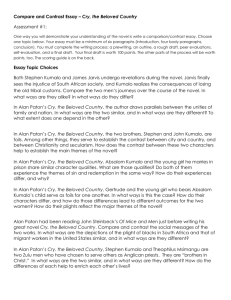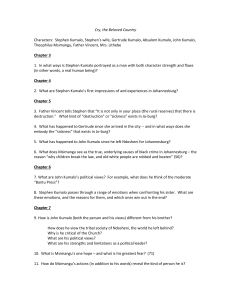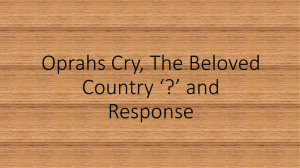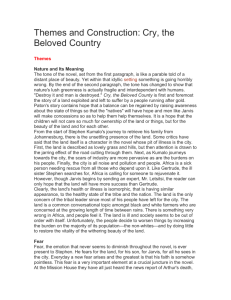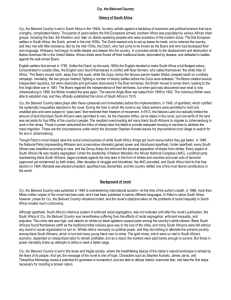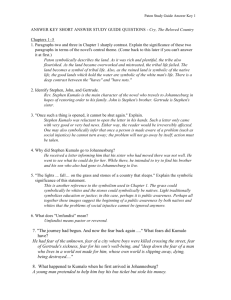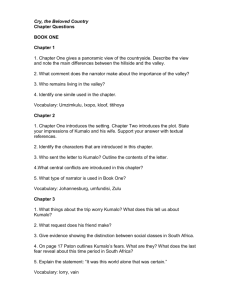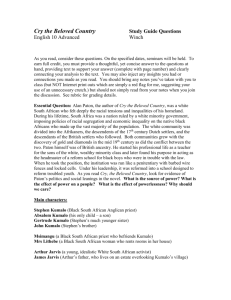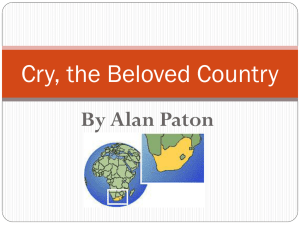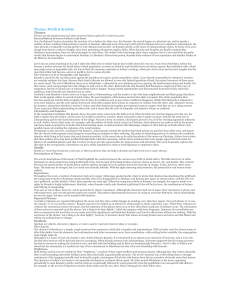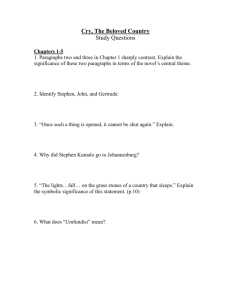Cry, article 2
advertisement
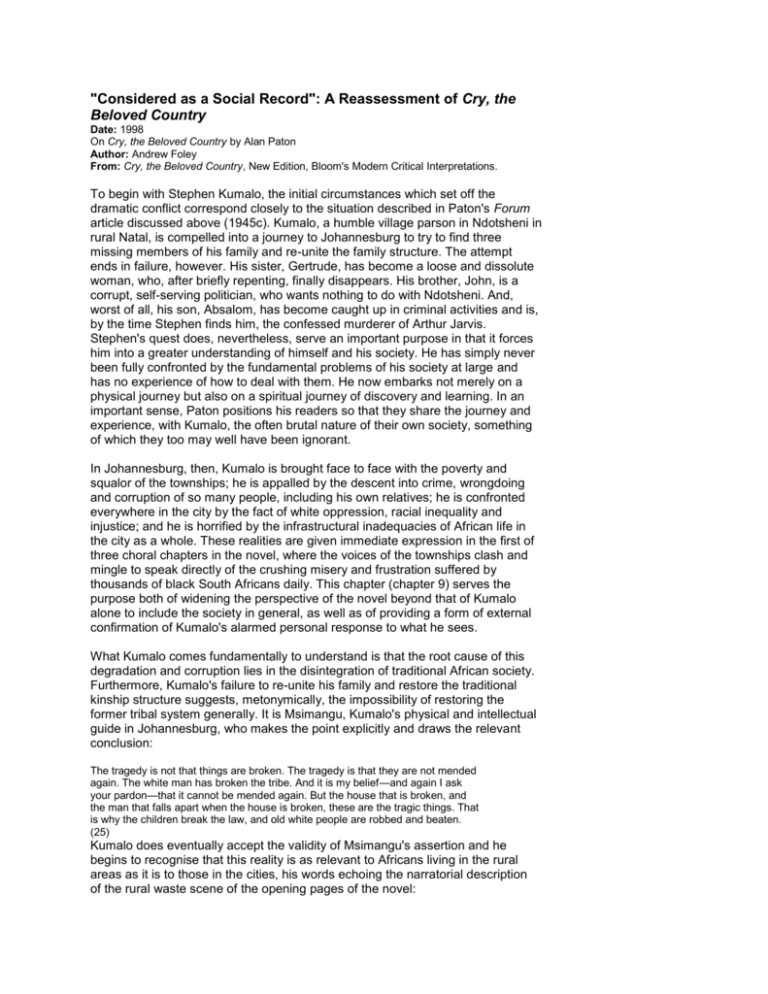
"Considered as a Social Record": A Reassessment of Cry, the Beloved Country Date: 1998 On Cry, the Beloved Country by Alan Paton Author: Andrew Foley From: Cry, the Beloved Country, New Edition, Bloom's Modern Critical Interpretations. To begin with Stephen Kumalo, the initial circumstances which set off the dramatic conflict correspond closely to the situation described in Paton's Forum article discussed above (1945c). Kumalo, a humble village parson in Ndotsheni in rural Natal, is compelled into a journey to Johannesburg to try to find three missing members of his family and re-unite the family structure. The attempt ends in failure, however. His sister, Gertrude, has become a loose and dissolute woman, who, after briefly repenting, finally disappears. His brother, John, is a corrupt, self-serving politician, who wants nothing to do with Ndotsheni. And, worst of all, his son, Absalom, has become caught up in criminal activities and is, by the time Stephen finds him, the confessed murderer of Arthur Jarvis. Stephen's quest does, nevertheless, serve an important purpose in that it forces him into a greater understanding of himself and his society. He has simply never been fully confronted by the fundamental problems of his society at large and has no experience of how to deal with them. He now embarks not merely on a physical journey but also on a spiritual journey of discovery and learning. In an important sense, Paton positions his readers so that they share the journey and experience, with Kumalo, the often brutal nature of their own society, something of which they too may well have been ignorant. In Johannesburg, then, Kumalo is brought face to face with the poverty and squalor of the townships; he is appalled by the descent into crime, wrongdoing and corruption of so many people, including his own relatives; he is confronted everywhere in the city by the fact of white oppression, racial inequality and injustice; and he is horrified by the infrastructural inadequacies of African life in the city as a whole. These realities are given immediate expression in the first of three choral chapters in the novel, where the voices of the townships clash and mingle to speak directly of the crushing misery and frustration suffered by thousands of black South Africans daily. This chapter (chapter 9) serves the purpose both of widening the perspective of the novel beyond that of Kumalo alone to include the society in general, as well as of providing a form of external confirmation of Kumalo's alarmed personal response to what he sees. What Kumalo comes fundamentally to understand is that the root cause of this degradation and corruption lies in the disintegration of traditional African society. Furthermore, Kumalo's failure to re-unite his family and restore the traditional kinship structure suggests, metonymically, the impossibility of restoring the former tribal system generally. It is Msimangu, Kumalo's physical and intellectual guide in Johannesburg, who makes the point explicitly and draws the relevant conclusion: The tragedy is not that things are broken. The tragedy is that they are not mended again. The white man has broken the tribe. And it is my belief—and again I ask your pardon—that it cannot be mended again. But the house that is broken, and the man that falls apart when the house is broken, these are the tragic things. That is why the children break the law, and old white people are robbed and beaten. (25) Kumalo does eventually accept the validity of Msimangu's assertion and he begins to recognise that this reality is as relevant to Africans living in the rural areas as it is to those in the cities, his words echoing the narratorial description of the rural waste scene of the opening pages of the novel: The tribe was broken and would be mended no more. The tribe that had nurtured him, and his father and his father's father, was broken. For the men were away, and the young men and the girls were away, and the maize hardly reached to the height of a man. (79) However, even in this moment of dark despair, there is already forming in his mind an incipient thought about the possibility of a way forward in restoration Thus, already present at this point in the novel—barely a third of the way through—is the implicit faith in the potential for the regeneration of society. Indeed, it is part of the general ethos of the book that even though the world might seem to be pervaded by evil and destruction there still remain many sources of goodness and generosity, and so it is possible for there to be, at least potentially, in the words of the novel's sub-title, "comfort in desolation." Even in his bleakest moments, Kumalo is comforted and sustained by Msimangu and others, and finds succour in sources unimagined. The implication is that this principle applies with equal validity at the level of the social and political. So, in one sense, the novel records the extent of the problem: Cry for the broken tribe, for the law and the custom that is gone. Aye, and cry aloud for the man who is dead, for the woman and children bereaved. Cry, the beloved country, these things are not yet at an end. (66) but it also suggests that there is enough humaneness and practical good-will in the world for the beloved country to be regenerated as a just and racially harmonious society. For example, although Kumalo is confronted continually by the injustice of a political system of white oppression, so too does he meet several instances of white men who have dedicated themselves to fighting that system and aiding the oppressed: the Afrikaner official at the Reformatory; Father Vincent at the mission; Mr Carmichael, the lawyer who takes Absalom's case pro deo; the white motorists who help the bus boycotters; and, of course, Arthur Jarvis himself. It is, in fact, clearly part of the novel's main purpose to make plain that the large proportion of blame for the current disintegration of black society in South Africa is to be laid squarely at the door of the whites, and so it is in large measure their responsibility to make amends and help to construct a new, integrated and equitable social order. Msimangu, in affirming that the old tribal structure cannot be mended, makes this clear: It suited the white man to break the tribe, he continued gravely. But it has not suited him to build something in the place of what is broken. I have pondered this for many hours and must speak it, for it is the truth for me. They are not all so. There are some white men who give their lives to build up what is broken. But they are not enough, he said. They are afraid, that is the truth. It is fear that rules this land.. .. They give us too little, said Msimangu sombrely. They give us almost nothing. (25–26) Msimangu's speech raises two vital issues in the novel: the responsibility of whites to participate actively in the restoration of society; and the pervasive fear which militates against their doing so. If the chorus of African voices in chapter 9 serves to confirm the extensiveness of the frustration and hardship suffered by black South Africans, then the corresponding chorus of white voices in chapter 12 emphasizes the ubiquitous fear and confusion in white society generally: Paton's response is to provide a portrait of one white man who does manage to move beyond his own prejudices and fears towards a greater understanding not only of the fundamental problems of his country, but also of the urgent necessity of attempting to solve them. . Like Stephen Kumalo, James Jarvis is a basically decent man living a sedentary farmer's life in the Natal hills. His quiet, comfortable world is shattered, however, by the news of his son's murder in his home in Parkwold, Johannesburg. As a result, he is led, again like Kumalo, on a quest to Johannesburg for his son, which becomes a voyage of discovery and learning about himself and his society. Although his son is already dead when he begins his journey, his search is to understand his son, through his writings and achievements, as he had never done when he was alive.
